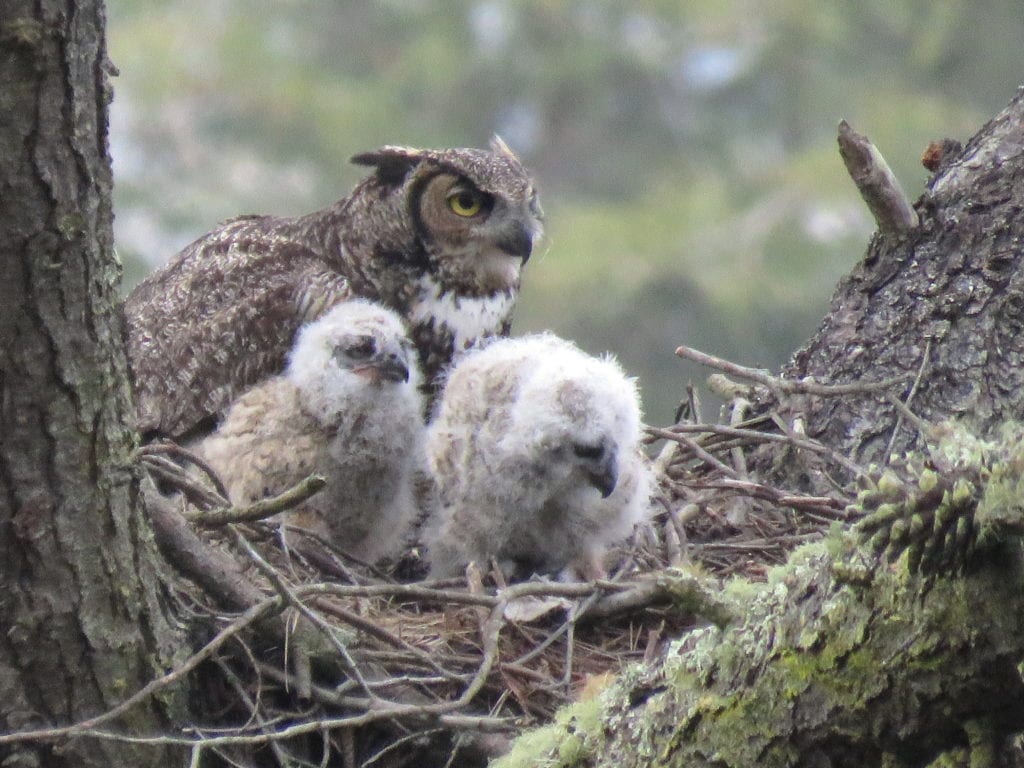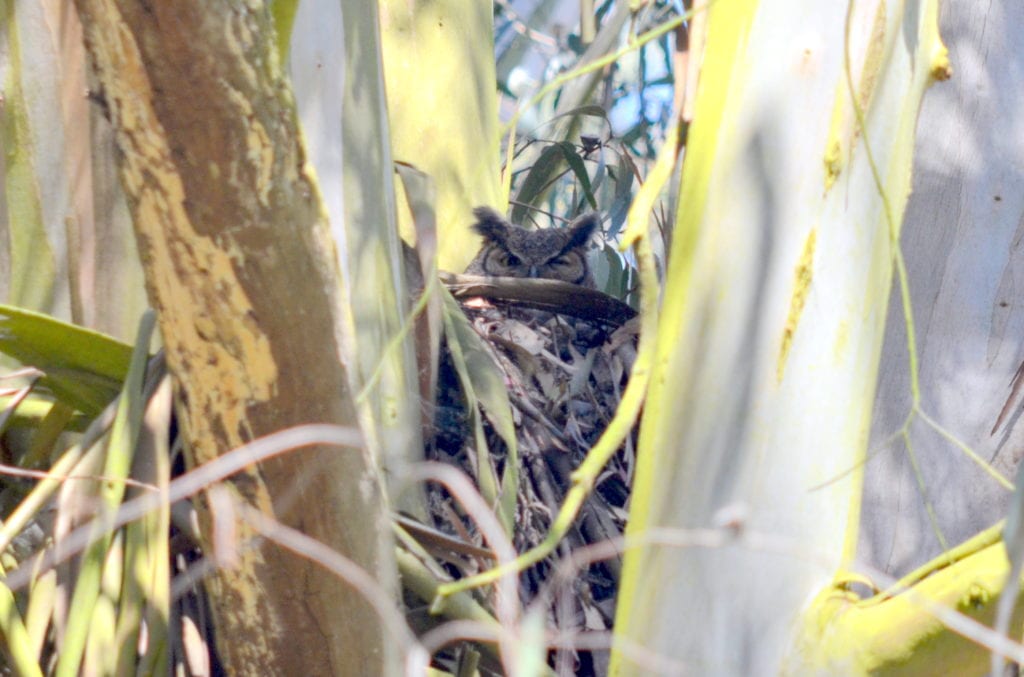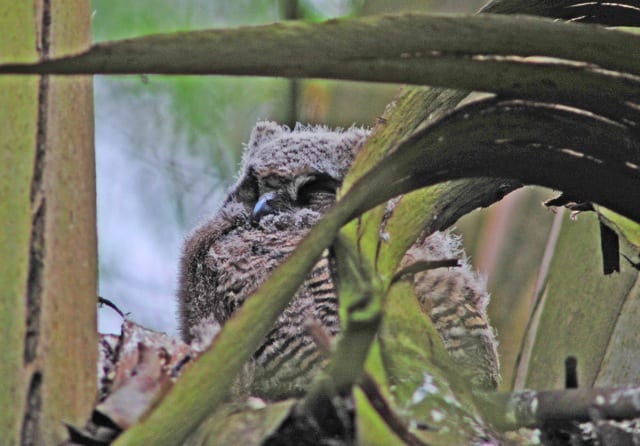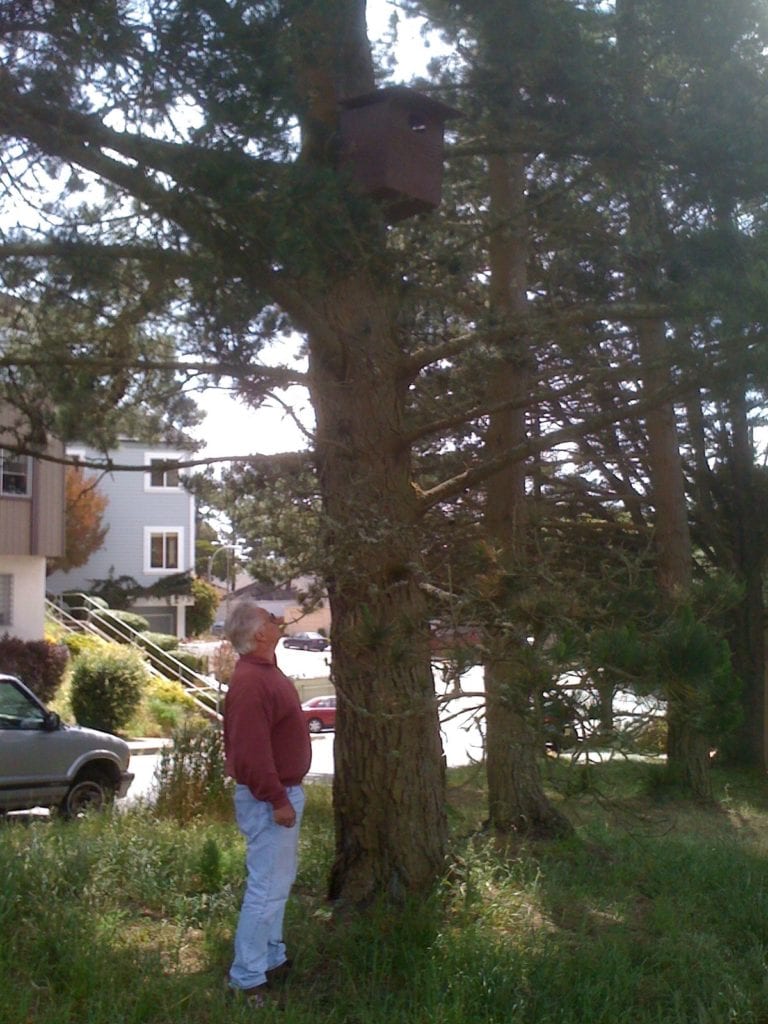
By Murray Schneider
The death of one of Glen Canyon’s great horned owls throws into stark relief the conundrum faced by areas working to both protect wildlife while also minimizing rodent infestations in homes and retail areas.
Each spring hundreds of Glen Park residents go to see an owl pair and their yearly broods of chicks in their nest in a eucalyptus tree near the Glen Canyon recreation center.
However in March, a female owl believed to be one of that pair was found dead in the park. A necropsy showed that the owl died after ingesting rodenticide, likely from eating a rat or mouse that had consumed rodenticide.
It’s a reminder of the difficulties wildlife face sharing a crowded urban area with some 10,000 humans, their retail stores and the inevitable trash that result.

Discovery and testing
The owl was discovered March 16 near the Bosworth Street entrance to Glen Canyon park by a preschool teacher on an outing with her students. She notified a Recreation and Park Department gardener working nearby with several Friends of Glen Canyon Park volunteers.
The gardener conferred with her Natural Areas Program supervisor and arrangements were made to transfer the bird’s body to California Department of Fish and Wildlife.
By March 23 Fish and Wildlife had issued a preliminary report. A gross necropsy showed the death was consistent with anticoagulant rodenticide toxicosis “with subcutaneous bleeding in the wing and bruising of the chest and abdomen.”
On April 19, with final confirming laboratory tests still pending, Stella McMillin, a senior Fish and Wildlife environmental scientist added details.
“The rodenticides that were detected in the owl, brodifacoum and difethialone, are second generation anticoagulants,” she emailed the Glen Park News.

Rodent control is necessary
Mice and rats pose a significant economic and health risk to people, according to the California Department of Pesticide Regulation. They directly spread 11 diseases and indirectly 15, as well as damaging homes, contaminating food, stores and restaurants and doing significant harm to crops. Because of that, California considers controlling them a priority.
That said, protecting wildlife is also a priority and the state has attempted to balance the needs of our state’s animal as well as human populations.
Rodenticides come in three types, first generation, second generation and non-coagulant. First generation rodenticides are available for sale to individuals but can require multiple feedings to kill mice and rats. Another issue was that in the 1970s Norway rats, roof rats, and mice began to develop resistance to these poisons.
That led to the development of second generation rodenticides. These are more effective because they require only a single feeding and no resistance has been reported. However the poisons have longer half-lives and can thus be more toxic to birds and mammals.
Because of that, in 2014 the state of California designated them restricted and they can only be used by licensed exterminators. Nationally, the Environmental Protection Agency placed similar restrictions on their use in 2015.
Without being controlled, rodents can run rampant in urban settings such as San Francisco and become a serious public health issue, said Dr. Richard Geller, medical director of California Poison Control System.
Compared to rat poisons used in the past such as strychnine and arsenic, the second generation rodenticide that killed the owl “does more good than harm,” said Geller. “Rat populations can explode, multiplying incredibly fast.”
Legions of rats left unchecked, in other words, would presumably overrun the capacity of San Francisco’s Department of Public Health to thwart them, and the few owls and hawks populating natural areas such as Glen Canyon might mount a good fight but lose the battle.
“It’s a trade-off between human safety and modern environmentalism,” continued Geller, who has practiced medicine for 29 years and was not unsympathetic to the plight of the canyon owl when he learned of it. ‘
Still, “strychnine was hideously toxic and brodifacoum is remarkably safer.”
A known hazard
Birds of prey such as owls, hawks and eagles that feed on rodents are at risk from secondary poisoning due to rodenticides when they eat animals that have consumed poisoned bait. The Department of Fish and Wildlife attributes hundreds of such deaths to rodenticides each year.
“Secondary poisoning of predators is a world-wide problem,” said Krysta Rogers,” a senior environmental scientist and avian specialist employed by Fish and Wildlife at its Wildlife Investigations Laboratory. “Anytime we can get the word out to the public it is important.”
This is the second owl death due to rodenticide ingestion in Glen Park in four years. In November 2012 officials performed a necropsy on another owl, whose death was also attributed to rodenticide.
Still, such occurrences are infrequent in San Francisco, said Joey Kahn, Rec and Park spokesperson. “Anytime something like this happens we investigate the situation in connection with San Francisco Animal Care & Control and California Department of Fish and Wildlife.”
The public can help
It’s likely the owl in question ate a mouse or rat that had eaten rodenticide relatively close by, as the species tends to stay close to its nests.
“Great horned owls are territorial and reside and return to certain areas,” said Rogers. “They don’t migrate like other owls. When chicks get old enough to fledge they eventually move away.”
Glen Park residents can make choices that will minimize the potential threat to local wildlife, say experts.
Fish and Wildlife’s Stella McMillin suggests non-lethal alternatives to the tamper-proof bait boxes often used near commercial properties.
“If residents would like to safeguard owls and other predatory and scavenging wildlife such as red-tailed hawks and coyotes, they should insure that any pest control business they hire is not using second-generation anticoagulants,” she said.
“Sanitation and exclusion are the best ways to control rodents. Take away anything that might attract them, pet food, seeds accumulating around bird feeders, fallen fruit, and then make sure all entry points to homes are sealed to prevent rodents from entering,” she said.
San Francisco’s Department of the Environment encourages residents to use alternatives to rid neighborhoods of rodents.
In the department’s ‘Don’t Take the Bait’ campaign in 2011, it asked 130 stores to remove the less lethal first generation products from their shelves. “One hundred stores pledged to do so,” the department’s head of safe pest management, Chris Gieger, told the Glen Park News in an email.
Others encourage residents to make safe habitats for raptors, which help keep down rodent population through their hunting.
Berkeley writer Lisa Owens Viani founded an organization called Raptors are the Solution that is dedicated to educating the public about secondary poisoning of owls, hawks and falcons.
“It is my belief that people should be given choices and there are other solutions to the rodent problem,” she said. “Raptors can’t do it alone, but if most people knew what secondary rodenticides such as brodifacoum do to raptors, they’d think twice and make the correct decisions.”
Keeping trash down and areas clear are key to reducing rodent infestations.
“We’re a messy species,” Owens Viani said. “Garbage and food on the street result in rodents, so proper sanitation is one of only several strategies.”
“But if we have to rid ourselves of rats,” she added emphatically, “then we should use snap traps.”
However she cautioned that such traps must be set carefully.
“They must be put in places, usually inside something, where other animals such as songbirds cannot be caught in them,” she said.
One Glen Park resident is doing his part to encourage birds of prey to take up residents here for a little localized rodent control.
Richard Craib has lived on Turquoise Way for 52 years. His Diamond Heights backyard abuts Glen Canyon and some years ago he took matters into his own hands. He built a number of barn owl boxes and placed them on the eastern slopes of Glen Canyon adjacent to Crags Court and Berkeley Way.
“I’d hear them hooting at night,” said Craib, a member of Friends of Glen Canyon Park. The smaller owl species shares the canyon with great horned owl. “Barn owls can eat four or five mice a night,” said Craib.
In fact, the barn owl has a much more prodigious appetite. A single barn owl, smaller than the great horned owl and sometimes prey for it, can consume 3,000 rodents in a single four-month period, nature’s efficacious alternative to indiscriminate killing by second generation rodenticides.

For additional information please see